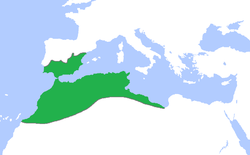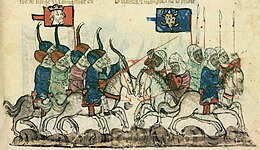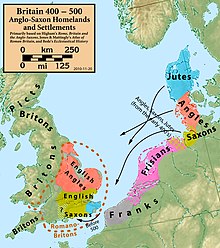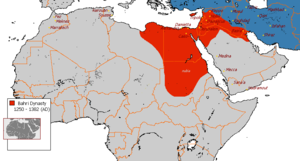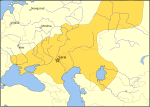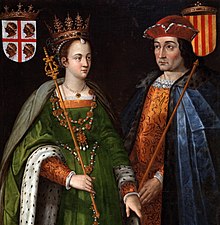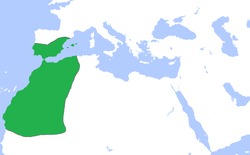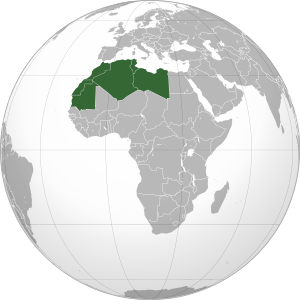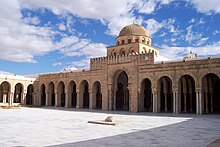Create Timeline -800 through 1350+ AD
http://en.wikipedia.org/wiki/Timeline_of_the_Middle_Ages
w. 0711 Tariq ibn-Ziyad crosses the Straits of Gibraltar. Al-Andalus holds most of the Iberian peninsula made up of Arab and Berber Muslims.
w. 0711 The end of Visigoth rule, starting almost eight centuries of Muslim presence.
w. 0712 Liutprand, King of the Lombards begins his reign (until 744).
c. 0712 Metropolitan epicopal see is established by the Assyrian Church in Chinese capital of Chang'an.
w. 0712 Emperor Xuanzong reign of 44 years until 756 is considered a period of one of China's high points.
w. 0713 Death of Dajian Huineng, sixth and last Patriarch of Chán Buddhism.
w. 0717 Siege of Constantinople. The Bulgarians come to the aide of the Byzantines and defeat the army of invading Arabs 718.
w. 0718 Bulgar aid completely neutralizes Muslim advance towards Europe. The Bulgarian army defeated between 20,000 and 32,000 Arabs.
w. 0718 Second Muslim attack on Constantinople, ending in failure. The combined Byzantine–Bulgarian forces stop the Arab threat in Eastern Europe.
w. 0726 Byzantine Emperor Leo III the Isaurian destroys the icon of Christ above the Chalke Gate in the capital city of Constantinople.
w. 0726 Byzantine Iconoclast movement begins, opposed by Pope Gregory II, a marked difference between the Roman and Byzantine churches.
w. 0732 Battle of Tours. the leader of the Franks Charles Martel defeats a large army of Moors under Cordoban, Abdul Rahman Al Ghafiqi.
w. 0732 The Battle of Tours halts the advance of Islam into West Europe, establishes a balance of power between West Europe, Islam & Byzantine.
w. 0735 Death of Bede. Bede later became regarded as "the father of history".
w. 0742 The Tang Dynasty creates a municipal census of the capital city Chang'an and the metropolitan areas of Jingzhou Fu
w. 0742 the New Book of Tang records that in this year there were 362,921 registered families with 1,960,188 persons.
w. 0748 The Chinese Buddhist monk Jian Zhen writes in his Yue Jue Shu of the international sea traffic coming to Guangzhou.
w. 0748 Canton some 80 miles from Hong Kong and Macao inland receives is a hub of trade from Borneo, Persia, Sri Lanka, Indonesia, and others.
w. 0750 The last Umayyad Caliph Marwan II reign after 6 years is overthrown and executed by the first Abbasid Caliph, Abu al-Abbas al-Saffah.
w. 0750 The Abbasid Caliphate is moved to Baghdad, within the Persian Empire; this would prove to be a momentous event for Baghdad.
w. 0750 Baghdad develops into a centre of trade and culture. The beginning of Abbasid Caliphate.
w. 0750 The Ghana Empire begins.
c. 0750 Great Wild Goose Pagoda at Ci'en Temple, Xi'an, Shanxi, is rebuilt.
c. 0750 Camel Carrying a Group of Musicians, tomb near Xi'an, Shanxi, Tang dynasty. It is now kept at Museum of Chinese History, Beijing.
w. 0751 Pepin founds the Carolingian dynasty.
w. 0751 Arabs defeat Chinese Tang Dynasty troops, Battle of Talas, high in the Pamirs near Samarkand conquering Central Asia completely.
w. 0754 Pepin promises the Pope central Italy. This is arguably the beginning of the temporal power of the Papacy.
w. 0755 The An Shi Rebellion lasts 8 years until 763 devastating China during the mid Tang Dynasty.
w. 0758 Arab and Persian pirates burn and loot the Chinese city of Guangzhou, while the Tang Dynasty authorities shut the port down.
w. 0758 China's Canton embargo's foriegn trade for the next five decades.
w. 0768 Pepin dies; Charles becomes king at Noyan and his brother Carloman becomes king at Soissons. Beginning of Charlemagne's reign.
w. 0772 Charlemagne invades what is now northwestern Germany, battling Saxons for more than 32 years and finally crushing their rebellion.
w. 0778 Battle of Roncevaux Pass.
w. 0781 Nestorian Monument is erected in China.
w. 0782 Buddhist monk Prajna reaches Chang'an and enlists the help of Christian bishop Ching Ching (Adam) in translating sutras into Chinese.
w. 0785 The Tang Dynasty begins landing regular maritime missions on the coast of East Africa, cutting out middlemen Arab sea merchants.
c. 0785 Chinese geographer Jia Dan describes large lighthouse pillars built in the Persian Gulf, which is confirmed a century later.
w. 0786 Accession of Harun al-Rashid in Baghdad.
w. 0787 The Empress Irene of Athens convenes the Seventh Ecumenical Council, ending the first phase of Byzantine Iconoclasm.
w. 0792 Battle of Marcelae. The Bulgarian victory over the Byzantines marks the end of the half-century political instability in Bulgaria.
w. 0793 The first written account of a Viking raid carried out on the abbey of Lindisfarne in northern England.
w. 0793 The Frisian–Frankish wars come to an end with the last uprising of the Frisians.
w. 0793 Sack of Lindisfarne. Viking attacks on Britain begin.
w. 0794 Emperor Kammu moves the capital to Heian-kyo (present day Kyoto), initiating the Heian period of Japan.
w. 0795 Death of Offa. Marks the end of Mercian dominance in England.
w. 0800 Beginning of the ancient West African state of Takrur or Tekrour, which flourished roughly parallel to the Ghana Empire.
w. 0800 On Christmas Day, Charlemagne is crowned the first Holy Roman Emperor by Pope Leo III.
w. 0800 Charlemagne is crowned Emperor of the Holy Roman Empire by Pope Leo III.
w. 0804 Saxony is incorporated into the Frankish Empire and the Christian world.
w. 0814 Death of Charlemagne.
w. 0825 Battle of Ellandun. Egbert defeats Mercians. Wessex becomes the leading kingdom of England.
w. 0827 Muslims invade Sicily.
w. 0840 Muslims capture Bari and much of southern Italy.
w. 0843 Division of Charlemagne's Empire between his grandsons with the Treaty of Verdun.
w. 0843 The end of Charlemagne's Empire sets the stage for the founding of the Holy Roman Empire and France as separate states.
w. 0840 Kenneth McAlpin becomes king of the Picts and Scots, creating the Kingdom of Alba.
w. 0862 Viking state in Russia founded under Rurik, first at Novgorod, then Kiev.
w. 0864 Christianization of Bulgaria.
w. 0866 Fujiwara period in Japan.
w. 0866 Viking "Great Army" in England. Northumbria, East Anglia, and Mercia were overwhelmed.
w. 0868 Earliest known printed book in China with a date.
w. 0871 Alfred the Great assumes the throne, the first king of a united England.
w. 0871 Alfred the Greatdefended England from Viking invaders, formed new laws and fostered a rebirth of religious and scholarly activities.
w. 0872 Harold Fairhair becomes King of Norway.
w. 0874 Iceland is settled by Norsemen.
w. 0885 Arrival of the disciples of Saints Cyril and Methodius in Bulgaria. Creation of the Cyrillic alphabet;
w. 0885 Bulgaria would in the following decades became the cultural and spiritual centre of the Eastern Orthodox Slavic World.
w. 0885 Vikings attack and invade Paris for several years.
w. 0893 Simeon I becomes ruler of the First Bulgarian Empire in the Balkans.
w. 0896 Arpad and the Magyars are present in Pannonia.
w. 0897 Death of Alfred the Great.
w. 0910 Edward the Elder, son of Alfred, defeats the Northumbrian vikings at the Battle of Tettenhall; raids south of the River Humber end.
w. 0910 Cluny Abbey is founded by William I, Count of Auvergne. Cluny goes on to become the acknowledged leader of Western Monasticism.
w. 0911 The Viking Rollo settles in what is now Normandy by the terms of the Treaty of Saint-Clair-sur-Epte, founding the Duchy of Normandy.
w. 0917 Battle of Anchialus. Simeon I the Great defeats the Byzantines. Recognition of the Imperial Title of the Bulgarian rulers.
w. 0919 Henry the Fowler, Duke of Saxony elected German King. First king of the Ottonian Dynasty.
w. 0919 Henry I considered the founder and first king of the medieval German state.
w. 0925 The first King of Croatia (rex Croatorum), Tomislav (910–928) of the Trpimirovic dynasty was crowned.
w. 0925 Tomislav of Croatia united Croats of Dalmatia and Pannonia into a single Kingdom creating a sizeable state.
w. 0927 According to Theophanes Continuatus, (The 2nd author of Theophanes's Chronicle) Tomislav defeats a Bulgarian army of Tsar Simeon I .
w. 0927 Croatia under Duke Alogobotur, in battle of the Bosnian Highlands, Bulgarian expansion into the west was stopped.
w. 0927 Death of Simeon I the Great. Recognition of the Bulgarian Patriarchate, the first independent National Church in Europe.
w. 0929 Abd-ar-Rahman III of the Ummayad dynasty in al-Andalus (Iberian peninsula) takes the title of Caliph or ruler of the Islamic world.
w. 0929 Beginning of the Caliphate of Córdoba (929-1031).
w. 0955 Battle of Lechfeld. Otto the Great, son of Henry the Fowler, defeats the Magyars.
w. 0955 The defeats the Magyars is the defining event that prevents the Hungarians from entering Central Europe.
c. 0960 Mieszko I becomes duke of Polans. First historical ruler of Poland and de facto founder of the Polish State.
w. 0962 Otto the Great crowned the Holy Roman Emperor.
w. 0964 Otto deposes Pope John XII who is replaced with Pope Leo VIII. Romans promise not to elect another Pope without Imperial approval.
w. 0965 For 2 years Mieszko I of Poland and his court embrace Christianity, which becomes national religion.
w. 0969 John I Tzimiskes murders Nikephoros II and is crowned Byzantine co-emperor in his place.
w. 0976 Death of John I Tzimiskes; Basil II (his co-emperor) takes sole power. Under Basil II zenith of the power of Eastern Empire after Justinian.
w. 0978 Al-Mansur Ibn Abi Aamir becomes de facto ruler of Muslim Al-Andalus. Peak of power of Moorish Iberia under "Almanzor".
w. 0981 Basil II (called "Bulgar Slayer") begins final conquest of Bulgaria by Eastern Empire. Conquest finished by 1018.
w. 0985 Eric the Red, exiled from Iceland, begins Scandinavian colonization of Greenland.
w. 0987 Succession of Hugh Capet to the French Throne. Beginning of Capetian Dynasty.
w. 1018 The Byzantines under Basil II conquer Bulgaria after a bitter 50-years struggle.
w. 1049 Pope Leo IX ascends to the papal throne.
w. 1050 The astrolabe, an ancient tool of navigation, is first used in Europe.
w. 1054 The East-West Schism which divided the church into Western Catholicism and Eastern Orthodoxy.
w. 1066 William the Conqueror, Duke of Normandy, invades England and becomes King after the Battle of Hastings.
w. 1066 End of Anglosaxon rule in England and start of Norman lineage
w. 1067 Pope Gregory VII elevated to the papal throne. This begins a period of church reform.
w. 1071 The Seljuks under Alp Arslan defeat the Byzantine army at Manzikert.
w. 1071 The Normans capture Bari, the last Byzantine possession in southern Italy. Beginning of the end of Byzantine rule in Asia Minor.
w. 1075 Dictatus Papae in which Pope Gregory VII defines the powers of the pope.
w. 1077 Holy Roman Emperor Henry IV walks to Canossa where he stands barefoot in the snow to beg forgiveness of the Pope for his offences.
w. 1077 Henry IV admits defeat in the Investiture Controversy. This helps establish Papal rule over European heads of state for another 450 years.
w. 1077 The Construction of the Tower of London begins. The tower of London was the ultimate keep of the British Empire.
w. 1086 The Domesday Book by William the Conqueror, a great land and property survey is the first since Roman times.
w. 1098 The Cistercian Order is founded.
w. 1099 First Crusade. Jerusalem is re-taken from the Muslims on the urging of Pope Urban II.
w. 1102 Kingdom of Croatia and Kingdom of Hungary formed a personal union of two kingdoms united under the Hungarian king.
w. 1102 The Union Croatia & Hungary (Pacta conventa) by which institutions of separate statehood were maintained through the Sabor.
w. 1102 The creation of an assembly of Croatian nobles and the ban (viceroy). In addition, the Croatian nobles retained their lands and titles.
w. 1102 Medieval Hungary and Croatia were (in terms of public international law) allied by means of personal union until 1526.
w. 1102 The Hungarian-Croatian state existed until the beginning of the 20th century and the Treaty of Trianon.
w. 1106 Sept. 28th, Henry I defeats older brother Robert Curthose, duke of Normandy, at the Battle of Tinchebrai, imprisoning him in Devizes.
w. 1106 Henry I imprisons Edgar Atheling and William Clito, [beginning conflicts] between England and the rising Capetian power in France.
w. 1107 Through the Compromise of 1107, suggested by Adela, the sister of King Henry, the Investiture Struggle in England is ended.
w. 1107 The Compromise of 1107 removed one of the points of friction between the English monarchy and the Catholic Church.
w. 1109 In the Battle of Naklo, Boleslaus III Wrymouth defeats the Pomeranians. Polish access to the sea is re-established.
w. 1109 Aug. 24th, the Battle of Hundsfeld, Boleslaus III Wrymouth defeats Emperor Henry V. German expansion to the east is stopped.
w. 1116 The Byzantine army defeats the Turks at Philomelion. The Turks abandon the entire coastal area of Anatolia and all of western Anatolia.
w. 1117 The University of Oxford is founded.
w. 1118 The Knights Templar are founded to protect Jerusalem and European pilgrims on their journey to the city.
w. 1121 Dec. 25th, St. Norbert and 29 companions make their solemn vows marking the beginning of the Premonstratensian Order.
w. 1121 The Premonstratensian Order played a significant role in evangelizing the Slavs, the Wends, to the east of the Holy Roman Empire.
w. 1122 Sept. 23rd, The Concordat of Worms between Emperor Henry V and Pope Calixtus II, ended the investiture struggle, bitter rivalry remained.
w. 1123 March, The First Lateran Council confirmed the Concordat of Worms.
w. 1125 Lothair of Supplinburg, duke of Saxony, is elected Holy Roman Emperor instead of the nearest heir, Frederick of Swabia.
w. 1125 The election of Lothair of Supplinburg, duke of Saxony marks the beginning of the great struggle between the Guelfs and the Ghibellines.
w. 1130 Dec. 25th, Roger II is crowned King of Sicily, a royal title given him by the Antipope Anacletus II.
w. 1130 This coronation of Roger II marks the beginning of the Kingdom of Sicily and its Mediterranean empire under the Norman kings,
w. 1130 Norman kings, [posessions, land & military might are] able to take on the Holy Roman Empire, the Papacy, and the Byzantine Empire.
w. 1139 April, The 2nd Lateran Council declars clerical marriages invalid, regulates clerical dress, & punishes attacks on clerics by excommunication.
w. 1147 For 2 years The Second Crusade [raged] in retaliation for the fall of Edessa, one of the first Crusader States founded in the First Crusade.
w. 1147 The Second Crusade was an overall failure. This was the first Crusade to have been led by European kings.
w. 1150 Ramon Berenguer IV, Count of Barcelona, married Queen Petronilla of Aragon. They had been betrothed in 1137.
w. 1150 Ramon Berenguer IV marriage gave the Kingdom of Aragon access to the Mediterranean Sea, creating a powerful kingdom.
w. 1150 Aragon expanded its control to many of the Mediterranean lands.
w. 1152 The Synod of Kells-Mellifont established the present diocesan system of Ireland and recognized the primacy of Armagh.
w. 1152 The Synod of Kells-Mellifont marks the inclusion of the Irish Church into western European Catholicism.
w. 1158 The Hanseatic League is founded, marking a new period of trade and economic development for northern and western Europe.
w. 1163 The first cornerstone is laid for the construction of Notre Dame de Paris.
w. 1171 King Henry II of England lands in Ireland to assert his supremacy and the Synod of Cashel acknowledges his sovereignty.
w. 1171 Henry begins the English claim to and occupation of Ireland which would last some seven and a half centuries.
w. 1174 July 12th, King William I of Scotland, captured in the Battle of Alnwick by the English, accepts the feudal lordship of the English crown.
w. 1174 King William I of Scotland does ceremonial allegiance at York, beginning the gradual acquisition of Scotland by the English.
w. 1175 Honen Shonin (Genku) founds the Jodo shu (Pure Land) sect of Buddhism. Beginning the Buddhist sectarian movement in Japan.
w. 1176 May 29th, the Battle of Legnano, the cavalry of Frederick Barbarossa is defeated by the infantry of the Lombard League.
w. 1176 the Battle of Legnano, the first major defeat of cavalry by infantry, signaling the new role of the bourgeosie.
w. 1179 March, The 3rd Lateran Council limits papal electees to the cardinals, condemns simony, forbids the promotion before age 30.
w. 1183 The final Peace of Constance between Frederick Barbarossa, the pope, and the Lombard towns is signed.
w. 1183 The Peace of Constance destroyed the unity of the [Holy Roman] Empire; Germany and Italy underwent separate developments.
w. 1183 The Taira clan are driven out of Kyoto by Minamoto Yoshinaka. A 2 year conflict which follows ends at the Battle of Dan no Ura (1185).
w. 1184 November, Pope Lucius III issues the papal bull Ad Abolendam. This bull set up the organization of the medieval inquisitions.
w. 1185 Windmills are first recorded.
w. 1185 The reestablishment of the Bulgarian Empire.
w. 1185 At the Battle of Dan no Ura, Minamoto Yoshitsune annihilates the Taira clan.
w. 1185 The elimination of the Taira leaves the Minamoto the virtual rulers of Japan and marks the beginning of the first period of feudal rule.
w. 1185 the Japanese rulership known as the Kamakura Period.
w. 1186 Jan, 27th, The future emperor Henry VI marries Constance of Sicily, heiress to the Sicilian throne.
w. 1186 The marriage of Henry VI shifts the focus of the Guelphs/Ghibelline struggle to Sicily marking the ruin of the House of Hohenstaufen.
w. 1187 Saladin recaptures Jerusalem.
w. 1188 Richard I of England, imposes heavy taxation to finance European ventures creates antipathy between barons, people and the crown.
w. 1188 Richard the I's absence enables the English to advance in their political development.
w. 1189 The Third Crusade follows upon Saladin's uniting the Muslim world and recapturing Jerusalem.
w. 1192 Despite managing to win several major battles, the Crusaders did not recapture Jerusalem.
w. 1192 Minamoto Yoritomo is appointed Sei-i Taishogun, shogun for short. First of a long line of military dictators to bear this title until 1913.
w. 1193 Turkic Muslim invaders sack and burn the university at Nalanda. This is the beginning of the decline of Buddhism in India.
w. 1193 The first known merchant guild.
w. 1202 The Fourth Crusade sacked Croatian town of Zadar (Italian Zara), a rival of Venice.
w. 1202 Venice is unable to raise enough funds to pay to their Venetian contractors.
w. 1202 Crusaders agreed to sack Zara despite letters from Pope Innocent III forbidding such an action and threatening excommunication.
w. 1202 Siege of Zara was the first major Crusade's action and the first attack against a Catholic city by Catholic crusaders.
w. 1204 Sack of Constantinople during the Fourth Crusade.
w. 1205 Battle of Adrianople. The Bulgarians under Emperor Kaloyan defeat Baldwin I. Beginning of the decline of the Latin Empire.
w. 1206 Genghis Khan was elected as Khagan of the Mongols and the Mongol Empire was established.
w. 1206 The Mongols would conquer much of Eurasia, changing former political borders.
w. 1208 Pope Innocent III calls for the Albigensian Crusade which seeks to destroy a rival form of Christianity practiced by the Cathars.
w. 1209 The University of Cambridge is founded.
w. 1212 Children's Crusade.
w. 1212 Spanish Christians succeed in defeating the Moors in the long Reconquista campaigns.
w. 1215 The Magna Carta is sealed by John of England, marking one of the 1st times a medieval ruler is forced to accept limits on his power.
w. 1215 4th Lateran Council. Dealt with transubstantiation, papal primacy and conduct of clergy.
w. 1215 4th Lateran Council. Jews and Muslims [are ordered to] wear identification marks to distinguish them from Christians.
w. 1216 Papal recognition of the Dominican Order.
w. 1223 Founding of the Franciscan Order.
w. 1248 only the small southern kingdom of Granada remained under Muslim control [in the Iberian Penisula of Spain].
w. 1257 Founding of the University of Paris.
w. 1257 Provisions of Oxford forced upon Henry III of England, establishes a new form of government-limited regal authority.
w. 1273 Rudolph I of Germany is elected Holy Roman Emperor. Habsburg domination of the crown that lasted until is dissolution in 1806.
w. 1274 Thomas Aquinas' work, Summa Theologica is published.
w. 1295 Marco Polo publishes his tales of China. A key step to the bridging of East and West
w. 1296 Edward I of England invades Scotland, starting the First War of Scottish Independence.
w. 1297 William Wallace emerges as the leader of the Scottish resistance to England.
w. 1307 Friday, October 13th. The Knights Templar are rounded up and murdered by Philip the Fair of France, backed by the Pope.
w. 1307 Beginning of the Babylonian Captivity of the Papacy during which the Popes moved to Avignon.
w. 1310 Dante publishes his Divine Comedy.
w. 1314 Robert the Bruce restores Scotland's de facto independence at the Battle of Bannockburn.
w. 1328 First Scottish War of Independence ends in victory with the Treaty of Edinburgh-Northampton and de jure independence.
w. 1337 The Hundred Years' War begins. England and France struggle for dominance of Western Europe.
w. 1347 The Black Death ravages Europe for the first of many times.
w. 1347 The Black Death kills an estimated 20% - 40% of the population of Europe within the first year.
w. 1347 The University of Prague is founded.
w. 1361 The fall of the Yuan Dynasty. Its successor state-Northern Yuan was founded in Mongolia.
w. 1361 The break up of the Mongol Empire, which marked the end of Pax Mongolica.
[Note: Work in Progress]
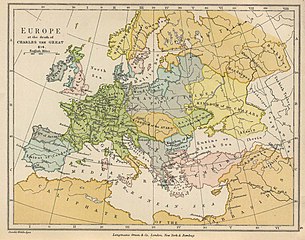











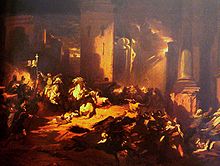
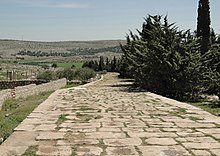
 I haven't felt like playing this game again yet but when I do I fully intend to try out this mod.
I haven't felt like playing this game again yet but when I do I fully intend to try out this mod.





